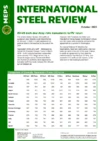Prices under negative pressure despite mill list hikes
October was expected to be a crucial month in determining the short-term direction of global steel prices. In Europe and North America, the mills’ efforts to reverse the negative trend are being strongly opposed by buyers.
European steelmakers are keen to recover their inflated production costs. Wholesale natural gas and electricity prices surged in the summer, as tensions between the European Union and Russia escalated.
As the authorities in the EU move closer to implementing a price cap on Russian-origin gas, benchmark prices on futures exchanges have fallen, but they remain substantially higher than the pre-conflict values. Reserves are likely to be limited through the winter period. This may prompt another spike in gas prices.
To minimise short-term cost volatility, varying degrees of government support have been introduced. For example, tax breaks for energy-intensive industries in Italy will give domestic steelmakers some relief with their bills. In the absence of an EU-wide policy to deal with the energy crisis, many steel mills have asked their customers to pay more for their products.
However, European buyers have been reluctant to place orders at the mills’ desired price levels because they face cost pressures of their own. Furthermore, most steel distributors and end-users are well stocked. Steelmakers throughout the continent are scaling down their production. Several operations have been mothballed. Despite these supply cuts, delivery lead times, for flat and long products, are short.
End-user activity is weaker than anticipated, for this time of year. Component shortages persist in the automotive and home appliance sectors. Moreover, deteriorating economic conditions are adversely affecting construction-related demand. To combat inflationary pressures, central banks in Europe and North America have announced interest rate rises. These increases are causing an uplift in mortgage costs, further cooling the residential housing market, in both regions.
As in Europe, North American steel prices have been on a downward spiral, in recent months. The negative trajectory is likely to continue in the short term. Trading activity, particularly at stockholders and distributors, has softened considerably.
Material is readily available, in North America. Steel manufacturers are starting to redress the supply/demand imbalance, by withdrawing capacity from their facilities, either publicly or privately. Capability utilisation, in the US, is dropping steadily. However, further supply-side actions are likely to be needed.
From a demand perspective, North American steel market participants must contend with similar economic concerns to those of their European counterparts – aside from the intensity of energy-related cost pressures. However, there is a key difference between the two regions.
US steel consumers appear to be heading into 2023 with a greater sense of optimism, than those based in Europe. Many current projects are likely to be expedited before the onset of winter. Furthermore, government-related infrastructure spending and reconstruction work, in many states, is expected to boost steel demand in the short-to-medium term. Carmaking is also projected to pick up during the same timeframe.
In China, a number of steel supply chain participants had expectations of a post-holiday market recovery, but this has failed to materialise. Policy measures, announced at the recent Communist Party Congress, will take time to boost the struggling domestic real estate sector.
With minimal improvement expected in the Chinese and wider East Asian markets, in the immediate future, MEPS predicts that European and North American steel producers will find it difficult to implement price increases, in the coming months. It is likely that more drastic supply cuts will be necessary, in both regions, to prompt a reversal of pricing fortunes for the mills.
However, the US steel market may be slightly better placed to bounce back, in the medium term. This is because of stronger demand fundamentals, and the reduced threat of recession, relative to that in many European countries.

Source:
International Steel Review
The MEPS International Steel Review is an essential monthly publication, offering professional analysis and insight into carbon steel prices around the world.
Go to productRequest a free publication





